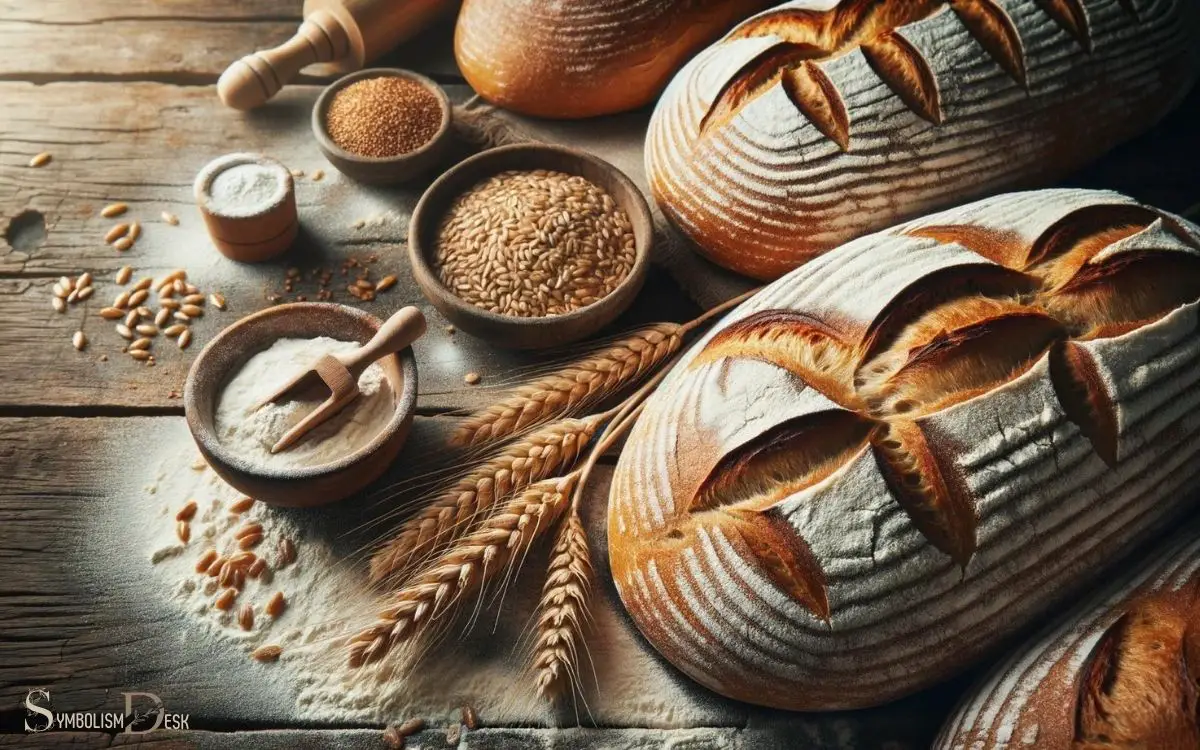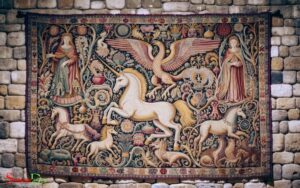What Is the Symbolic Meaning of Bread? Life!
The symbolic meaning of bread encompasses a range of interpretations including life, sustenance, community, spirituality, and sharing. It is a powerful emblem in numerous traditions, representing fundamental human necessities and virtues.
Bread, as a staple food, holds deep symbolic value:
- Life and Sustenance: It is often called ‘the staff of life,’ representing the basic needs for human survival.
- Community and Sharing: Breaking bread together is a universal sign of peace and friendship, signifying communal bonds.
- Religious Significance: In Christianity, bread symbolizes the body of Christ during the Eucharist. It also plays a role in Jewish rituals, like the Sabbath and Passover.
- Fertility and Prosperity: In some cultures, bread is associated with abundance and the harvest.
For example, during a Christian communion service, bread is used to represent the sacrifice of Jesus, embodying the concept of spiritual sustenance.
| Culture/Tradition | Symbolic Meaning |
|---|---|
| Christianity | The body of Christ |
| Judaism | Sabbath and Passover |
| General | Life and nourishment |
Bread’s symbolism extends beyond mere food; it embodies rich cultural ethos and sacred rites.

Key Takeaway
Bread as a Symbol of Life and Nourishment
One of the most prevalent symbolic meanings of bread is its representation as a source of life and nourishment for many cultures and religions.
Throughout history, bread has been seen as a fundamental staple, essential for sustaining life. In various cultures, the act of breaking bread together symbolizes unity, sharing, and hospitality.
The significance of bread as a symbol of nourishment is deeply rooted in religious practices as well.
- In Christianity, bread is a central element of the Eucharist, representing the body of Christ and providing spiritual nourishment.
- Similarly, in Judaism, bread holds a sacred place in rituals such as the blessing of the Sabbath bread.
This symbolism underscores the vital role that bread plays in sustaining both the body and the spirit, making it a powerful and universal symbol of life and nourishment.
Bread in Religious and Spiritual Contexts
When examining the symbolic meaning of bread, it becomes evident that in religious and spiritual contexts, bread holds significant importance as a representation of nourishment and divine presence.
In various religious traditions, bread is used in sacred rituals and ceremonies to symbolize the provision of sustenance for both the body and the soul.
Additionally, bread is often seen as a symbol of hospitality and community, emphasizing the importance of sharing and unity among individuals.
Furthermore, in spiritual teachings, bread is associated with the concept of spiritual nourishment, indicating the sustenance of the soul through divine wisdom and enlightenment.
- The act of breaking bread together fosters a sense of communion and kinship.
- The sharing of bread embodies the principles of generosity and compassion.
- Bread is often used in religious ceremonies to symbolize the presence of the divine.
Bread as a Symbol of Sharing and Community
Bread holds a symbolic significance as a representation of sharing and community. It brings people together, fostering a sense of unity and generosity.
Through the act of breaking bread, individuals bond and create a sense of belonging within their community.
Bread Unites Communities
Communities unite through bread’s symbolic representation of sharing and interconnectedness. Bread has the power to bring people together, transcending cultural and social boundaries.
It symbolizes the act of sharing not only food but also experiences, stories, and traditions. This creates a sense of belonging and solidarity among community members.
Breaking bread signifies trust and openness, fostering deeper connections among individuals.
Sharing bread is a universal gesture of hospitality, showing warmth and acceptance to others.
The act of baking and sharing bread fosters a sense of collaboration and unity, as people come together to create something that nourishes and sustains the community.
Through these symbolic meanings, bread becomes a powerful force in uniting communities, promoting empathy, understanding, and a shared sense of belonging.
Bread Fosters Generosity
Fostering generosity and a sense of community, bread serves as a powerful symbol of sharing and interconnectedness, uniting people across cultural and social boundaries.
In many cultures, the act of breaking bread together signifies hospitality, warmth, and a willingness to share with others.
This age-old tradition not only nourishes the body but also feeds the soul, creating a bond between individuals.
By offering bread to others, whether it’s a loaf shared among friends or a community meal, people express their willingness to provide for one another and create a sense of belonging.
This act of giving and receiving bread fosters a spirit of generosity and togetherness, promoting a harmonious and supportive community.
Through this simple yet profound gesture, bread becomes a powerful symbol of unity and sharing, transcending differences and building connections among people.
Bread as a Metaphor for Sustenance and Provision
Society relies on bread as a metaphor for essential sustenance and provision, reflecting the fundamental human need for nourishment and support. This metaphor carries powerful emotional connotations, evoking feelings of comfort, security, and stability.
When people think of bread as sustenance and provision, they often associate it with:
- Warmth and nourishment, akin to a comforting embrace on a difficult day.
- The security of having one’s basic needs met, offering a sense of stability and safety.
- The provision of sustenance not just for oneself, but for loved ones, symbolizing care and support for others.
These emotional responses demonstrate how deeply ingrained the metaphor of bread as sustenance and provision is in human consciousness, illustrating the universal importance of nourishment and support in our lives.
Bread in Cultural and Historical Symbolism
Bread holds deep cultural and historical symbolism, serving as a powerful representation of sustenance and provision in various traditions.
It also plays a significant role in religious rituals, symbolizing spiritual nourishment and unity.
Exploring the diverse ways in which bread has been woven into the fabric of cultural and historical symbolism offers valuable insights into the human experience and the significance we attribute to this staple food.
Bread as Sustenance Symbol
In many cultures, bread serves as an essential symbol of sustenance and nourishment, embodying the fundamental human need for sustenance and the sharing of food.
- The aroma of freshly baked bread evokes feelings of warmth and comfort, reminding people of home and family.
- Breaking bread together fosters a sense of community and togetherness, creating bonds and fostering relationships.
- The act of sharing bread symbolizes generosity and hospitality, promoting feelings of goodwill and connection.
Understanding the symbolic significance of bread as a source of sustenance provides insight into the deep-rooted cultural and historical meanings associated with this staple food. This understanding sets the stage for exploring the role of bread in religious rituals.
Bread in Religious Rituals
The role of bread in religious rituals has been a longstanding tradition across various cultures and faiths, signifying spiritual significance and communal unity.
- In Christianity, bread is a central element of the Eucharist, symbolizing the body of Christ and shared among congregants to commemorate the Last Supper.
- In Judaism, bread holds great importance in the form of Challah, a braided bread used in various ceremonies and symbolizing the manna that sustained the Israelites during their exodus from Egypt.
- In Hinduism, offering bread during religious ceremonies is a way of showing hospitality and respect to deities, while in Islam, bread plays a significant role during Ramadan, where it’s consumed to break the fast.
Across these diverse traditions, the use of bread in religious rituals underscores its deep-rooted cultural and historical symbolism.
Are Bread and Milk Both Considered Symbolic of Life and Fertility in Different Cultures?
Bread and milk have long been considered symbolic of life and fertility in different cultures. In many societies, bread represents the cycle of life and sustenance, while milk symbolizes fertility and nourishment. Both foods hold deep cultural and spiritual significance, representing the symbolic meaning of fertility across various traditions.
Bread as a Representation of Rituals and Traditions
Symbolizing the continuation of age-old customs and practices, bread plays a significant role in various cultural rituals and traditions.
- Breaking bread together signifies unity, fostering a sense of belonging and togetherness within a community.
- The act of kneading and baking bread is often passed down through generations, serving as a tangible link to ancestry and heritage.
- Bread is a central element in many celebratory events, such as weddings and religious holidays, symbolizing abundance, gratitude, and the sharing of blessings.
These traditions surrounding bread evoke a deep emotional connection to collective history and shared experiences.
The presence of bread in rituals and traditions not only sustains the body but also nourishes the soul, creating a profound sense of continuity and belonging within cultural practices.
Conclusion
As a symbol, bread represents life, nourishment, community, and tradition across various cultures and religions. In Christianity, bread plays a central role in the Eucharist, symbolizing the body of Christ and the spiritual nourishment of believers. In Judaism, bread is a key element in many religious ceremonies, including the weekly observance of Shabbat. Moreover, in many cultures, the act of breaking bread together signifies unity and fellowship. In a similar way, ‘christmas tree symbolism‘ embodies the festive spirit of the holiday season and represents the celebration of life, hope, and joy.
It embodies the idea of sharing and sustenance, as well as the spiritual and historical significance of rituals and traditions.
Bread serves as a reminder of the interconnectedness of humanity and the importance of coming together to share in the nourishment and abundance of life.
Its symbolism is deeply ingrained in our collective consciousness, making it a powerful and enduring cultural symbol.






